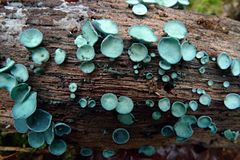Helotiales
| Helotiales | |
|---|---|
 | |
Chlorociboria (Helotiaceae) | |
Scientific classification | |
| Kingdom: |
Fungi |
| Division: |
Ascomycota |
| Subdivision: |
Pezizomycotina |
| Class: |
Leotiomycetes |
| Order: |
Helotiales Nannf. ex Korf & Lizon (2000) |
Families | |
| |
Helotiales is an order of the class Leotiomycetes within the division Ascomycota.[1] According to a 2008 estimate, the order contains 10 families, 501 genera, and 3881 species.[2]
Helotiales is the largest order of inoperculate discomycetes. It contains the famous blue-green cup fungi that makes its home on oaks is known by the genus name Chlorociboria.[3]
Habit
Helotiales is distinguished by its disc or cup-shaped apothecia.- Its asci are only slightly thickened in contrast to other Leotiomycetes
- Most Helotiales live as saprobes on soil humus, dead logs, manure and other organic matter.
- The order includes most fungi that engage in ericoid mycorrhiza. Including Rhizoscyphus ericae, Meliniomyces species and Cairneyella variabilis.
- The order contains some of the worst plant pathogens such as Monilinia fructicola (Brown rot on stone fruits), Sclerotinia sclerotiorum (Lettuce drop and other diseases), D. rosae (black spot of roses), Sclerotium cepivorum (Soft rot of onions)
See also
- List of Helotiales genera incertae sedis
References
^ Lumbsch TH, Huhndorf SM (December 2007). "Outline of Ascomycota – 2007". Myconet. Chicago, USA: The Field Museum, Department of Botany. 13: 1–58. Archived from the original on 2009-03-18..mw-parser-output cite.citation{font-style:inherit}.mw-parser-output .citation q{quotes:"""""""'""'"}.mw-parser-output .citation .cs1-lock-free a{background:url("//upload.wikimedia.org/wikipedia/commons/thumb/6/65/Lock-green.svg/9px-Lock-green.svg.png")no-repeat;background-position:right .1em center}.mw-parser-output .citation .cs1-lock-limited a,.mw-parser-output .citation .cs1-lock-registration a{background:url("//upload.wikimedia.org/wikipedia/commons/thumb/d/d6/Lock-gray-alt-2.svg/9px-Lock-gray-alt-2.svg.png")no-repeat;background-position:right .1em center}.mw-parser-output .citation .cs1-lock-subscription a{background:url("//upload.wikimedia.org/wikipedia/commons/thumb/a/aa/Lock-red-alt-2.svg/9px-Lock-red-alt-2.svg.png")no-repeat;background-position:right .1em center}.mw-parser-output .cs1-subscription,.mw-parser-output .cs1-registration{color:#555}.mw-parser-output .cs1-subscription span,.mw-parser-output .cs1-registration span{border-bottom:1px dotted;cursor:help}.mw-parser-output .cs1-ws-icon a{background:url("//upload.wikimedia.org/wikipedia/commons/thumb/4/4c/Wikisource-logo.svg/12px-Wikisource-logo.svg.png")no-repeat;background-position:right .1em center}.mw-parser-output code.cs1-code{color:inherit;background:inherit;border:inherit;padding:inherit}.mw-parser-output .cs1-hidden-error{display:none;font-size:100%}.mw-parser-output .cs1-visible-error{font-size:100%}.mw-parser-output .cs1-maint{display:none;color:#33aa33;margin-left:0.3em}.mw-parser-output .cs1-subscription,.mw-parser-output .cs1-registration,.mw-parser-output .cs1-format{font-size:95%}.mw-parser-output .cs1-kern-left,.mw-parser-output .cs1-kern-wl-left{padding-left:0.2em}.mw-parser-output .cs1-kern-right,.mw-parser-output .cs1-kern-wl-right{padding-right:0.2em}
^ Kirk PM, Cannon PF, Minter DW, Stalpers JA (2008). Dictionary of the Fungi (10th ed.). Wallingford, UK: CABI. p. 310. ISBN 978-0-85199-826-8.
^ Kuo M. (2004). "Chlorociboria aeruginascens & C. aeruginosa". Retrieved 29 August 2009.
This Leotiomycetes-related article is a stub. You can help Wikipedia by expanding it. |
This plant disease article is a stub. You can help Wikipedia by expanding it. |

Comments
Post a Comment